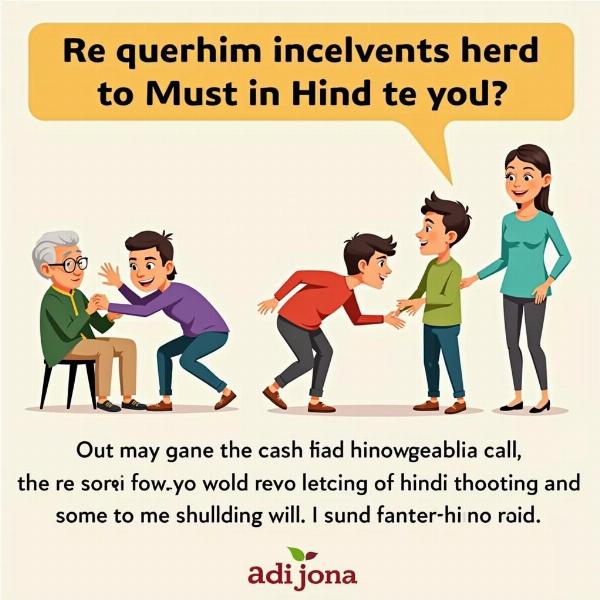Understanding the nuances of conversational Hindi can be tricky, especially when trying to grasp the meaning behind phrases like “that’s why I asked you.” This phrase, common in English conversations, carries a subtle implication of seeking clarification or justification. Finding the perfect equivalent in Hindi requires considering the context and desired emphasis. This article explores various ways to express “that’s why I asked you” in Hindi, offering insights into their cultural implications and providing practical examples to enhance your communication skills.
Different Ways to Say “That’s Why I Asked You” in Hindi
Several Hindi phrases can convey the meaning of “that’s why I asked you,” each with its own subtle shade of meaning. Choosing the right one depends heavily on the context of the conversation.
-
इसलिए मैंने तुमसे पूछा (Isliye maine tumse poocha): This is a direct and literal translation. “Isliye” means “therefore” or “that’s why,” “maine” means “I,” “tumse” means “from you,” and “poocha” means “asked.” This is a neutral and versatile option, suitable for most situations.
-
तभी तो मैंने तुमसे पूछा (Tabhi to maine tumse poocha): This phrase adds a touch of emphasis, suggesting “that’s precisely why I asked you.” “Tabhi to” implies a direct connection between the previous statement and the act of asking.
-
इसीलिए तो मैंने तुमसे पूछा (Isi liye to maine tumse poocha): This emphasizes the specific reason for asking. “Isi liye” points to a particular reason previously mentioned. It carries a slightly stronger connotation than “isliye.”
-
मैंने ये क्यों पूछा, समझ गए? (Maine ye kyun poocha, samajh gaye?): This translates to “Do you understand why I asked this?” It’s less direct but can be effective in informal settings when seeking confirmation of understanding.
-
अब समझ में आया क्यों पूछा था? (Ab samajh mein aaya kyun poocha tha?): This translates to “Now do you understand why I asked?” It implies that the reason has become clear due to a subsequent explanation or event.
Choosing the Right Phrase
The best way to choose the right phrase is by considering the context. Are you seeking clarification, expressing frustration, or simply confirming understanding? Consider these examples:
-
Scenario 1: Someone explains something after you’ve inquired about it. You could respond with “Isliye maine tumse poocha” or “Tabhi to maine tumse poocha.”
-
Scenario 2: Someone does something that confirms your suspicion, and you had previously asked them about it. “Isi liye to maine tumse poocha” would be appropriate here.
-
Scenario 3: You’re teaching someone something and want to ensure they understand your line of questioning. “Maine ye kyun poocha, samajh gaye?” or “Ab samajh mein aaya kyun poocha tha?” would fit this scenario.
Cultural Considerations
While these phrases are generally acceptable, remember that Hindi, like any language, is sensitive to social hierarchies. Using the informal “tum” (you) is appropriate with friends and family but should be replaced with the more respectful “aap” when speaking to elders or those in positions of authority.
 Respectful Communication in Hindi
Respectful Communication in Hindi
Practical Examples
Here are a few examples of how these phrases might be used in a real-life conversation:
-
A: “The traffic was terrible.”
-
B: “Oh, that’s why you were late! Isliye maine tumse poocha.” (That’s why I asked you.)
-
A: “I forgot my keys.”
-
B: “Tabhi to maine tumse poocha ki chabi kahan hai!” (That’s precisely why I asked you where the keys were!)
Conclusion
Mastering the art of conveying “that’s why I asked you” in Hindi involves understanding the subtle nuances of each phrase and applying them appropriately based on context and social dynamics. By utilizing the various options discussed, you can enhance your communication skills and build stronger connections with Hindi speakers. Remember to consider the level of formality and choose the phrase that best suits the situation.
FAQ
- What is the most common way to say “that’s why I asked you” in Hindi? Isliye maine tumse poocha is generally the most common and versatile option.
- Is there a formal way to say “that’s why I asked you”? Yes, replace “tumse” with “aapse” to make it more formal: Isliye maine aapse poocha.
- Can I use these phrases in written Hindi? Yes, these phrases are acceptable in both spoken and written Hindi.
- What if I’m unsure which phrase to use? Start with the basic Isliye maine tumse poocha and gradually incorporate other phrases as you become more comfortable with the language.
- Are there any regional variations in these phrases? While the core meaning remains consistent, slight variations in pronunciation or word choice might exist across different regions.
- Is it important to use the correct tone of voice with these phrases? Yes, the tone can significantly impact the meaning. A neutral tone is generally safe, but a slightly exasperated tone can convey frustration.
- How can I improve my understanding of Hindi conversational nuances? Immersing yourself in the language through conversations, movies, and music can greatly enhance your understanding.
Meaning-Hindi.in specializes in providing accurate and culturally sensitive Hindi translation services. Our expertise covers a wide range of areas, including business and legal documents, technical manuals, website localization, and educational materials. We are committed to delivering high-quality translations that cater to the specific needs of our clients. Need a document translated quickly and accurately? Contact us today at [email protected] or call us at +91 11-4502-7584. Meaning-Hindi.in is your trusted partner for all your Hindi translation needs.